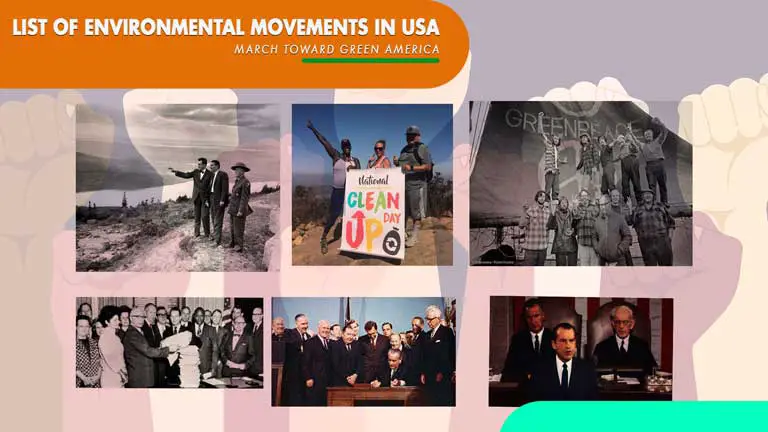
The environmental movement had been successful instead of having multidisciplinary challenges. Because it was supposed to bring a tangible increase in daily life quality, it gifts Americans a cleaner, safer, and more beautiful environment. You will find a list of Environmental Movements in the USA here in this article & a timeline of the American environmental movement to read.
A healthy environment is required for securing a better future, and it needs to ensure by proper action and movement. With the reawakening of the modern-day environmental movement worldwide and its growth in the last decades of the twentieth century, Environmental movements are to preserve the environment for future generations and make life better for those already living. That targeted to reduce the impact of human centric activities on the earth and its various inhabitants.
For people to be involved in the environmental movement and act on current issues, they must know and skills to do so. Only spending time close to nature and an eco-friendly lifestyle is not enough for environmental safeguard. Instead, it is essential for the environmental movement (sometimes referred to as the ecology movement), including conservation and green politics. It is diversified with the philosophical, social, and political movement for addressing environmental issues.
List Of Environmental Movements in USA : The Brief Happening Of Environmental Movement in the United States:
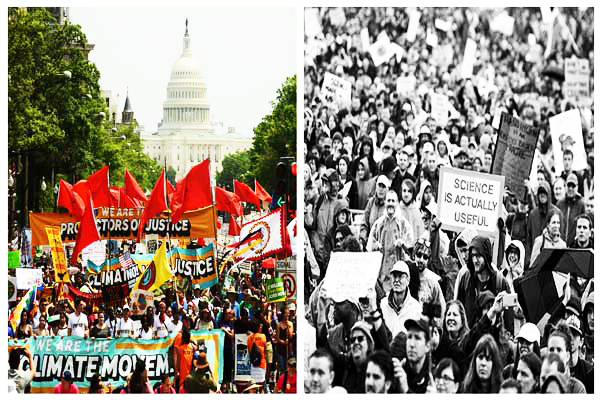
The brief happening of Environmental movement in the United States.
At the beginning of the conservation movement of the 20th century, the contemporary environmental movement’s roots can be traced back to –
- Murray Bookchin’s “Our Synthetic Environment.”
- Paul R. Ehrlich’s “The Population Bomb.”
- Rachel Carson’s “Silent Spring.”
American environmentalists have campaigned against –
- Thermonuclear weapons and nuclear power plants in the 1960s and 1970s
- Acid raining in the 1980s
- Ozone layer decay and deforestation in the 1990s
- Most recently, the effects of climate change and global warming.
The United States passed many bills of environmental legislation in the 70s, such as
- “The Clean Water Act.”
- “The Clean Air Act”
- “The Endangered Species Act.”
- “The National Environmental Policy Act.”
These are working as the foundations for current environmental standards.
Before go deeply the historical journey about the list of Environmental movements in USA, lets dig into about “environmental movement”.
Environmental Movement :
“Without a movement, nothing starts
Without an action, nothing reveals
Without a march, nothing activates!”
The quote revealed a lot about the sacred movement towards the green revolution and created a revolutionary pathway for the green war in everyone’s mind.
The environmental movement is a roadmap towards a divine path of natural conservation. It becomes history when something revolutionary happens. It opens our eyes to think from different angles & direction. It takes us towards a different dimension about which we were never aware of before. It is a march for ecological consciousness to change the world to re-think green for good!
What is the Environmental Movement?
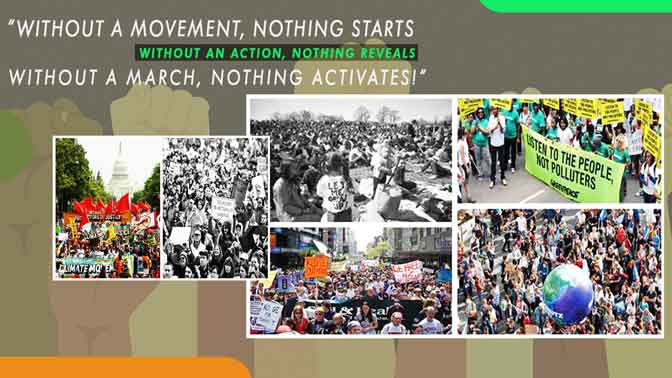
The environmental/ecological movement includes conservation and green politics. It is a diverse scientific, social, and political movement to address environmental issues. Environmentalists bring sustainable management of resources. They do so by bringing change in public policy and individual behavior. It recognizes humanity as a part of an ecosystem. The movement centered on ecology, health, and human rights.
It’s an international movement. It’s represented by a range of organizations, from the large to grassroots, and It also varies from country to country. The environmental movement is not often whole in its goals. The reason is its large membership, a variety of strong beliefs, and occasionally speculative nature. The movement also encompasses movements with a specific focus, such as the climate movement. The movement advocated by various stekholders like private citizens, professionals, religious devotees, politicians, scientists, nonprofit organizations and individual initiatives.
Who Started The Revolutionary Roadmap Towards The Environmental Movement?
When you talk about the environment, Rachel Carson will appear as the first inseparable name. Rachel Carson is the revolutionary scientist & the first green writer. She’s the author of “Silence Spring”.
There she tells a story about the toxic effect of DDT on the environment and human health. She wrote the book in 1962, which was way ahead of her time. She made people rethink their relationship with the natural world.
She was the person who felt that we all are part of nature which are connected deeply. Her mother nature towards the environment aware everyone sees the greener side. She was one of the finest biologist & conservationist writers who changed the world forever.
To activate her movement and to educate people through her influential book, she faced lots of backlashes. Besides struggling with her personal life & career direction, she faces threats from industries, corporations, bureaucrats, and so on.
Let’s See The Origins of The Environmental Movement
We began to see more & more environmental problems worldwide in the 50s, 60s & the 70s. At that timeline, all the natural resources were abundant. As with global economic growth, people all around the world started using natural resources aggressively.
They used to transform those resources into products. They were cutting down trees to create furniture, home requirements, papers, etc. In the process of energy production, they burnt down coal to produce electricity.
Thus emitting pollutants into the open sky became common. The most promising way to protect the environment was for the governments to step in and make laws. It was the only way to restrict the marketplace’s mistakes, which was considered a market failure.
During that period, all the economic books revealed all the environmental problems, all the environmental degradation & issues. The profit system caused it. It means all the businessmen, corporations, industries & investors had desires to make a high level of profit with the lowest possible cost.
They would create pollutants and dump those in rivers, oceans, sky, landfills & so on. That is why the market was characterized by pollution, which was called negative externalities. The solution to this may well lie in the Soviet Union regions. Because in Soviet regions the industries ran for fulfilling the demand of all the people and good for whole of the nation. That is why those Russian regions were known as environmental heaven as they have a low level of pollutions.
In the 70s, people started to look behind the iron curtain, and they were horrified to see the higher level of environmental problems. But there was far worse environmental cost accumulated by US & Western Europe. That was sort of a perplexing problem for a lot of people. And if you go to the 1960s, a large amount of young student movement started to protect the planet. Students’ revolution & student uprising at that time became a very fashionable trend. In the 60s antiwar movement started. About thousands of students were marching down Pennsylvania Avenue in Washington DC. They all were carrying red flags & they have chairman Mao’s little red book. They knew capitalism is evil & destroying the planet & argue to get rid of capitalism.
Just after the war ended in Vietnam, all these young kids interestingly started to march! They were sort of radicalized, anti-free market, anti-capitalism, anti-profit system, and anti-private property rights, which kept them marching.
A more exciting thing started when they switched their Bible. Instead of holding up Chairman Mao’s little red book, they held up Rachel Carson’s little green book. That green book had much the same philosophy as the reason behind their movement.
The belief was capitalism did not care about the planet, and the incredible thing was that those young kids were marching for the green. That was the origin of the environmental movement for the whole period. It also called for the birth of Earth day.
The first earth day held on April 22nd in 1970 coincidently, or not that happens to be Lennon’s birthday! Many young kids were marching at that time; they thought it was a joke and in-your-face kind of thing. They were celebrating earth day on Lennon’s birthday because they knew that capitalism was destroying the environment.
In the 60s and 70s of the last century, the environmental movement has drawn its attention to pollution. It successfully pressured Congress to pass bills that promote cleaner air and water.
In the late 70s, the movement alarmingly addressed environmental threats caused by the disposal of toxic waste. At the end of the century, environmental goals also included other worldwide problems, such as ozone layer decay and global warming.
Let’s have a look at the “Timeline of US environmental Movements history”
- 1832– Hot Springs Reservation
- 1864– Yosemite Valley
- 1872– Yellowstone National Park
- 1892– Sierra Club
- 1916– National Park Service Organic Act
- 1916– National Audubon Society
- 1949– UN Scientific Conference on the Conservation and Utilization of Resources
- 1961– World Wildlife Foundation
- 1964– Land and Water Conservation Act
- 1964– National Wilderness Preservation System
- 1968– National Trails System Act
- 1968– National Wild and Scenic Rivers System/Wild and Scenic Rivers Act
- 1969– National Environmental Policy Act
- 1970– First Earth Day- 22 April
- 1970– Clean Air Act
- 1970– Environmental Protection Agency
- 1971– Greenpeace
- 1972– Clean Water Act
- 1973– Endangered Species Act
- 1980– Earth First
- 1992– UN Earth Summit in Rio de Janeiro
- 2017- First National Clean Up Day
Now let’s have a look at the first powerful movements in the United States-
#World Wildlife Foundation (1961) Environmental Movement In USA:
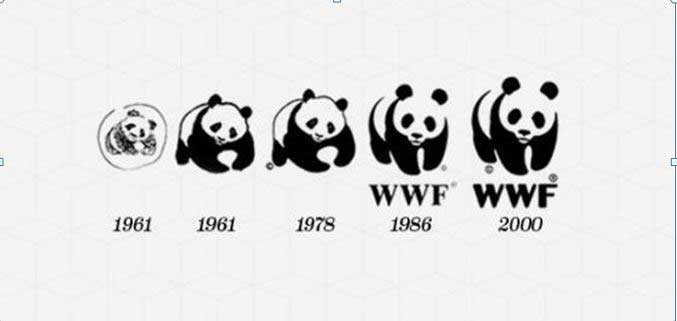
The World Wide Fund for Nature (WWF) is an international, non-governmental organization, founded in 1961 in Switzerland. They started their work for wilderness preservation and lessened humanity’s footprint on the environment. It was named the World Wildlife Fund formerly, which is still its official name in Canada and the United States. Most of its offices are situated in Switzerland. Their mascot, or logo, is a Giant Panda.
Mission:
“Building a future in which people live in harmony with nature.”
It is the world’s most prominent independent wildlife preserving organization, and It has over 5 million supporters, working in more than 90 countries. WWF supports 15,000 conservation and environmental projects all over the globe. It is a charity based organization. About 90% of its fundraising money comes from the donations of private individuals and businesses.
The organization says its motto is “to halt and reverse the destruction of our natural environment”. A fair share of its work focuses on the preservation of three biomes of the world’s biodiversity:
- forests
- freshwater ecosystems
- Oceans and coasts.
It also works for endangered species, pollution, and climate change. The organization operates on more than 1,200 field projects worldwide every year.
Origin:
The first urge for broader support was the Morges Manifesto. WWF signed in 1961 by 16 of the world’s leading conservationists, including –
- biologist and African wildlife specialist Sir Julian Huxley
- IUCN vice president Sir Peter Scott
- Director-general of the British Nature Conservancy E. M. Nicholson.
Morges Manifesto stated that the expertise to protect the world environment existed, but there is no financial support. The decision was made to establish WWF as an international fundraising organization. It would enable working in collaboration with existing conservation groups. It also would bring substantial financial support to the conservation movement on a worldwide scale.
Let’s see an Interesting fact about WWF! What WWF is doing for the European wolf?
WWF is strengthening wolf populations in Europe, e.g., by helping them spread into suitable areas. This includes research operations to evaluate wolf populations. They also address the concerns of farmers and locals who feel threatened by the presence of wolves. WWF is working to protect the habitats and ecosystems on which the wolf depends.
Have you heard about the incredible journey of Slavc, the wolf who traveled 200 km to find his Juliet?

In 2011, Slavc began an epic 2,000 kilometer migration run across Europe from Slovenia to Italy via the Austrian Alps. Several months earlier, he had been attached with a collar that allowed his movements to be tracked down in incredible detail. The works of Hubert Potočnik, a biologist, made this possible.
#National Environmental Policy Act (1969) Environmental Movement In USA
In the 1960s, the US was experiencing an environmental revolution. In 1969 President Nixon created The Environmental Protection Agency. He signed the National Environmental Policy Act (NEPA) into the legislature. Federal agencies must conduct a NEPA analysis to assess environmental impact. An example of NEPA analysis includes permits to mine coal, extract oil, and build pipelines.
The purposes of this Act are:
“To declare a national policy which will encourage productive and enjoyable harmony between man and his environment-
To promote efforts that will prevent or eliminate damage to the environment and biosphere and stimulate man’s health and welfare.
To enrich the understanding of the ecological systems and natural resources necessary to the Nation
And To establish a Council on Environmental Quality”.
NEPA addresses both impacts from a single significant action. It also asses the cumulative effects of an action repeated across a landscape. NEPA proponents say the process is a crucial avenue for public participation. But critics say NEPA can delay projects and discourage investments. There are three levels of NEPA analysis:
- Categorical Exclusion (CATX)
- Environmental Assessment (EA)
- Environmental Impact Assessment (EIA)
Among all three levels, the EIA is the most rigorous.
Categorical Exclusion (CATX):
Agencies can use a categorical exclusion when a proposed action resemblance a previous action. In those cases, agencies identify those type of activity – does not significantly harm the environment.
Environmental Assessment (EA):
During EA, agencies conduct Environmental Assessment when the effects of an action are uncertain unless the agency discovers significant environmental concerns. It provides a Finding of No Significant Impact (FONSI). In about 1% of cases, an agency will prepare an environmental impact statement.
Environmental Impact Assessment (EIA):
Through project requirements on statement though projects requiring in EIAs are unusual. They attract more attention because of their costs, complexity, and prominence. The agency first conducts a scoping process to determine appropriate stakeholder involvement. A draft EIAs is then subject to public comment. The final EIA must incorporate and respond to the feedback. The agency then submits a record of decision (ROD) and implements the action. This process can take years.
Recently, the Trump administration has tried to simplify the NEPA process. The interior department, for example, has imposed time and page limits on NEPA analyses.
Trump’s white houses have also attempted to de-emphasize climate considerations in NEPA reviews. The courts have repeatedly required agencies to weigh those impacts.
#Clean Air Act (1970) Environmental Movement In USA :
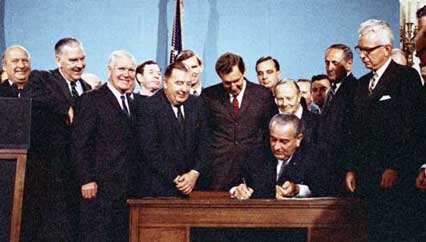
What is the 1970 Clean Air Act?
The Clean Air Act (CAA) of 1970 was one of the major federal environmental laws. Later it amended to prevent air pollution, protect the ozone layer, and promote public health. The CAA gave power to the Environmental Protection Agency (EPA) to take effective action for fighting environmental pollution.
What was the aim of the Clean Air Act of 1970?
The CCA launched an ambitious set of federal programs to establish air quality goals. It aims to impose pollution control technology requirements on new and existing stationary sources and motor vehicles.
Who passed the Clean Air Act of 1970?
President Richard Nixon signed the Clean Air Act on December 30, 1970. He intended to foster a strong American economy and industry while improving human health and the environment.
What has been the major success of the Clean Air Act?
Experience with CCA shows that public health protection and building the economy can go side by side. Clean Air Act programs have lessen levels of six common pollutants –
- particles
- ozone
- lead
- carbon monoxide
- nitrogen dioxide
- sulfur dioxide
- As well as many toxic pollutants.
Is the Clean Air Act successful?
The Clean Air Act has proven to be a remarkable success. Bush signed amendments that toughened emission standards. Those were about two hundred toxic substances, mostly were cancer-causing air pollutants.
The Clean Air Act has helped:
- Reduce ground-level ozone, a dangerous ingredient of smog, by more than 25 percent since 1980
- Cut down mercury emissions by 45 percent since 1990;
- Reduce the prime pollutants that contribute towards acid rain. Those are sulfur dioxide and nitrogen dioxide, reduced to 71 percent and 46 percent, respectively since 1980;
- Phase out the production and use of chemicals that cause the hole in the ozone layer; and
Reduce the lead consumption of gasoline, which has cut lead air pollution by 92 percent since 1980.
#Greenpeace Environmental Movement (1971) In The United State
The Greenpeace environmental movement is known worldwide. Now it has offices in more than 40 countries and has almost 3 million supporters. It is generally acknowledged that the date, September 15, 1971, marked the beginning of the international movement, which began in Canada. A ragtag group of 12 activists went out on a fishing trawler from Vancouver, British Columbia, to protest against US nuclear testing in Alaska. It had a humble beginning, however.
Purpose of Greenpeace environmental movement
It made an impression in drawing worldwide public attention to a host of environmental concerns, and they include commercial whaling, genetic modification of crops, global warming, and nuclear testing. Its mission statement disallows violence. But then again, its critics say that its campaigning tactics have triggered extremism.
History & origin of Greenpeace
The Quakers, ecologists, pacifists, journalists, and hippies started Greenpeace. They dreamed big, and it was an infectious one. In 1971 in Vancouver, the newly founded “Don’t Make a Wave Committee” chartered a ramshackle old fishing boat. They went out to oppose the testing of nuclear bombs by the US government in Amchitka, Alaska. It was the beginning of the international movement of Greenpeace. Within a few years, Greenpeace had spread to several countries. They also started a campaign on other environmental issues such as toxic wastes and commercial whaling.
In 1972 the US forsook the nuclear testing grounds at Amchitka Island, Alaska. Many other protests at test sites in the South Pacific followed the movement. It eventually led to the comprehensive “Nuclear Test Ban Treaty” adopted by the United Nations in 1996.
In the late 1970s, several different Greenpeace groups brought together and formed Greenpeace International. They oversee the goals and operations of the organization globally. The international profile of Greenpeace raised significantly during the 1980s. During that time, the French intelligence agency bombed the Rainbow Warrior in Auckland. It was the most famous of the ships operated by Greenpeace. The incident resulted in the killing of one of the crew members, the photographer Fernando Pereira.
Today, Greenpeace is an international organization that emphasizes global environmental campaigns. Greenpeace has nearly 3 million supporters worldwide and is based in Amsterdam, the Netherlands. It also has national as well as regional offices in 40 countries.
What has been its success, and why?
In 1982, years after the iconic Greenpeace Sea actions against commercial whaling, a moratorium was adopted by the International Whaling Commission. In 2002 there was a significant drive by pro-whaling in Japan and its supporters to re-introduce commercial whaling. Greenpeace defeated it. They remain vigilant in defending the oceans by challenging wasteful and destructive fishing. They also campaigned to create a global network of marine reserves.
- Greenpeace was one of the first environmental movements to plan a sustainable development scenario for climate change mitigation and ozone depletion. They played a significant role in raising public awareness of global warming in the 1990s. They also highlighted the effect of CFCs on the ozone layer in the Montreal Protocol. They developed a CFC-free refrigerator technology named “Greenfreeze“. They conducted mass production with the refrigerator industry. By the end of 2007, one-third of the world’s total output of refrigerators was followed by Green freeze technology.
The turning century saw an ever-increasing number of European retailers, food producers, and multinational companies’ subsidiaries. They guaranteed to remove genetically engineered components from products due to consumer pressure.
In 2008, six Greenpeace UK volunteers were accused of criminal damage by a UK Crown Court jury. The case centered on the contribution made toward climate change by burning fuel, mainly coal. The charges were introduced after six attempts to shut down the Kingsnorth coal-fired power station in Kent in 2007.
They did it by rescaling the exhaust chimney and painting the Prime Minister’s name down the side. The defendants pleaded ‘not guilty’ and depended upon the court to defend ‘lawful excuse’. They claimed they shut the power station down to defend the property of more excellent value from the global impacts of climate change. This landmark case is marked as the first victory of the ‘lawful excuse’ defense in Britain’s climate-change case.
In 2010 they created the following of a two months innovative campaign. It involved Facebook, Twitter, and other social media profiles. They made Nestlé agreed to stop purchasing palm oil from sources that destroyed Indonesian rainforests.
This followed a similar campaign against Unilever. Eventually, that palm oil company also accepted a groundbreaking deal from Greenpeace in 2012. And after ten years of continuous campaigning, Europe finally banned the trade of illegal timber. It was a great leap forward in the struggle to protect the world’s forests and climate.
Let’s have a look at the Key Events of Greenpeace
- 1969: ‘Don’t Make A Wave Committee’ emerges in Vancouver, Canada. The organization’s first acts are blocking the Canadian border with Alaska to halt nuclear tests and later observance of criteria.
- 1971: Group renamed itself ‘Greenpeace’.
- 1972: David McTaggart successfully brings worldwide attention by dodging New Zealand and French navies to disrupt nuclear testing in the Pacific.
- 1973: McTaggart savagely got beaten by French commandoes while disrupting nuclear tests again.
- 1975–1979: McTaggart arranges Greenpeace organizations across Europe. This led up tothe formation of ‘Greenpeace International’ in 1979.
- 1985: Rainbow Warrior got bombed by French Special Forces.
- 1991: Greenpeace Support reaches a total of 4.8 million.
- 2001: David McTaggart dies in a car crash in Italy.
#Clean Water Act (1972) Another Successful Environmental Movement In USA:
The Clean Water Act (CWA) was initially known as the Federal Water Pollution Control Act. It adjusts the emission of pollutants into the nation’s surface waters. The industry could pollute lakes, rivers, streams, wetlands & coastal areas, and the law aim to combat this issue. The Act was passed in 1972, amended in 1977 and 1987. The administrative body of the CWA is the U.S. Environmental Protection Agency (EPA). The EPA sets –
- Water quality standards
- Handles enforcement
- Helps state and local governments to develop their pollution control plans.
What was the Goal of The Clean Water Act?
The Act’s original goal was to eliminate the discharge of untreated wastewater from municipal and industrial sources. Thus make the American waterways safe for fishing and swimming. It needs to be noted, the use of surface water for drinking purposes is covered under separate legislation, the Safe Drinking Water Act. The federal government provided billions of dollars as grants to finance the sewage treatment facilities around the country. The CWA also required businesses to apply for federal permits to discharge pollutants into waterways. In this way, the Act reduces the number of discharges over time.
Pointing its credits:
The Clean Water Act has been credited for significantly lessening the amount of pollution that goes inside the nation’s waterways from “point sources.”
Those “Point sources” are municipal and industrial discharges. As of 1998, 60% of the American lakes, rivers, and shorelines were declared clean enough for swimming and fishing.
Jeff Glasser and Kenneth T. Walsh in U.S. News & World Report wrote that “In the years following the passage of the Clean Water Act, the EPA largely succeeded in stemming the ‘point source’ discharges of significant industrial and municipal offenders, whose pipes spewed chemicals directly into oceans, rivers, lakes, and streams.” He added, “It has become clear, however, that ‘point source’ pollution is only part of the problem.”
#Endangered Species Act(1973) Another Fruitful Environmental Movement In USA
The Endangered Species Act (ESA) issues a program for preserving ecosystems where all the threatened & endangered fish, wildlife & plants live. The 1973 ESA established federal action and encouraged the establishment of state programs.
Which President established the US Endangered Species Act of 1973?
Richard Nixon was the founder. He designed to protect critically imperiled species from extinction. Economic growth and development untampered by adequate concern and conservation lead to such tragedy. The ESA was introduced into law by President Richard Nixon on December 28, 1973.
What are the lead federal agencies for implementing it?
ESA provides such services-
- The U.S. Fish and Wildlife Service (FWS)
- The U.S. National Oceanic and Atmospheric Administration (NOAA) Fisheries Service.
They ensure that actions they authorize, fund, or carry out are not likely to jeopardize any listed species’ existence. It also provides so that their activities do not destruct or adversely modify such species’ critical habitat. ESA also prohibits the import, export, interstate, and foreign commerce of listed species.
What happens if you accidentally kill an endangered species?
The ESA is the government policy that determines how all the endangered species are regulated. You will have committed a serious crime punishable by significant fines and jail time if you violate it by killing an endangered animal.
Is the Endangered Species Act effective?
It’s instrumental. Passed with bipartisan support in 1973, the ESA is America’s most influential law to protect endangered species from extinction. Grizzly bears, eagles, and humpback whales bald are just a few of the 46 species which are now listed as recovered under the ESA.
#1992– UN Earth Summit in Rio de Janeiro another rewarding Environmental Movement In USA
What summit met in Rio de Janeiro Brazil in 1992 and what was the result of that summit?
United Nations Conference on Environment and Development (UNCED), by name Earth Summit. Its’ conference held in Rio de Janeiro, Brazil (June 3–14, 1992). It aims to reconcile worldwide economic development with the protection of the environment.
Why was Rio de Janeiro Earth Summit 1992 held?
In June 1992, more than 100 heads of states met in Rio de Janeiro, Brazil, for the first International Earth Summit. It held for addressing urgent problems of environmental protection and socio-economic development at the global level.
What was the outcome of the Rio Summit?
The United Nations Conference on Sustainable Development held in Rio de Janeiro, Brazil on 20 to 22 June, 2012. It resulted in a prioritized political outcome document. Those documents contain clear and practical measures for implementing sustainable development.
The Rio summit produced conventions dealing with climate change, biodiversity, and forestry. It approved a list of development practices named the ”Agenda 21″. This summit gave the idea of sustainable development. It leads to the combining effort of economic growth with ecological responsibility.
The issues addressed included:
- Systematic production pattern of toxic components. It has: lead in gasoline or other poisonous waste, including radioactive chemicals
- Alternative sources of energy to substitute fossil fuels. We need to be aware; fossil fuel is directly linked to global climate change.
- New reliance on public transportation systems. It would reduce vehicle emissions, city congestion, and health problems caused by polluted air and smoke.
- The growing demand and limited supply of water.
Achievements & agreements:
- A vital achievement of the summit was an agreement on the “Climate Change Convention”. This led to the “Kyoto Protocol” and the “Paris Agreement”.
- Another agreement was not to carry out any movements on the lands of indigenous peoples. It would cause ecological degradation, or that would be culturally unsuitable.
- The “Convention on Biological Diversity” was introduced to sign at the Earth Summit.
- Twelve cities were also honored by the “Local Government Honors Award” for innovative local environmental programs. It included Sudbury in Canada for its ambitious program to –
- Retain environmental damage from the local mining industry
- Austin in the United States for its green building strategy
- Kitakyūshū in Japan for assimilating an international education and training element into its municipal pollution control program.
The Earth Summit resulted in the following documents:
- “Rio Declaration on Environment and Development.”
- “Agenda 21”
- “Forest Principles”
Moreover, relevant legally binding agreements (Rio Convention) were opened for signature:
- Convention on Biological Diversity
- Framework Convention on Climate Change (UNFCCC)
- United Nations Convention to Combat Desertification
What was the importance of the Rio de Janeiro Earth Summit 1992?
The purpose of the conference was to
- Rethink economic growth
- Advance social equity and
- Ensure environmental protection.
#First National Clean Up Day of 2017

The third Saturday of September is celebrated annually as “National Cleanup Day” in the United States. It encourages both organized and individual cleanup events and volunteering to keep the outdoors clean.
The inaugural National Cleanup Day held in 2017 had more than 225,000 volunteers. The 2018 event had over 1,500,000 volunteers. From the campaign, 14 million pounds of waste collected. It was held in conjunction with World Cleanup Day. National Cleanup Day partners include-
- Earth Day
- Keep America Beautiful
- World Cleanup Day
- Waterkeeper Alliance
- National Parks Conservation Association
- Junior Chamber International
- Granite Gear
- Fjallraven
- Clean Trails
In April 2019, “Earth Day” partnered with National Clean Up Day. They promised to Keep America Beautiful for the inaugural Earth Day Clean Up. They had over 500,000 volunteers working to clean up trash and litter nationally.
Concluding Remark
Eeww…ww.. I know its long historical read about List Of Environmental Movements in USA, but I am pretty sure you got enough idea about the timeline of the American environmental movement.
By the end of the twentieth century, many environmentalists showed a new concern, the aim of sustainable development. It searched for long-term planning to integrate environmental goals with social and economic ones. Yet even as environmental organizations addressed global issues such as population growth, global warming, and fossil fuel resources’ exhaustion. The American public remained more concerned with more physical issues such as air and water pollution.
Indeed, the environmental movement had been a successful event because it had promised a substantial increase in everyday life quality. It gifts Americans a cleaner, safer, and more beautiful environment. Moreover, mobilizing popular support to combat more abstract and long-term ecological threats presented environmentalists with a challenge.
A visionary Naturalist Vinson Brown is the author of the excellent book named “Warriors of the Rainbow: Strange and Prophetic Indian Dreams”. He stated a bold & divine vision in his one tale of prophecy –
“The people of the world would join together to save the world from destruction.”
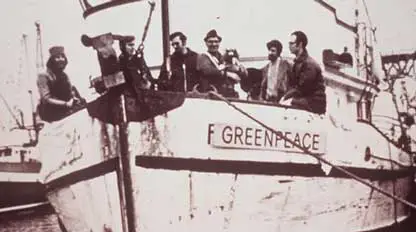
Do you have a list of all the environmental movements that have existed over X amount of time in the USA? and perhaps any legislation that was associated with each movement?